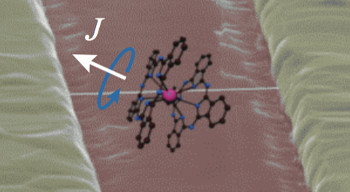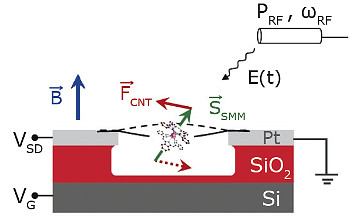Nano electromechanical systems
Carbon nanotubes and magnetic molecules are considered building ideal blocks of future nanoelectronic systems due to an impressive array of mechanical, electrical and magnetic properties. During this work, we found a way to combine both components on a molecular level and to build the smallest magnetic field sensor in the world. We made a link between the classical and quantum world using a molecular system constructed with the combined knowledge of physics, chemistry and electrical engineering.
For this purpose, we first built in Grenoble, Institut Néel, NanoSpin, a nanoscale vibrating guitar string made of a single carbon nanotube. Using the newest nanofabrication techniques adapted from the semiconductor industry, one can reproducibly suspend a carbon nanotube over a 1 micrometer wide trench between two metallic electrodes with exceptional mechanical properties (Figure below). Via chemical engineering, one can then design an organic molecule that behaves like a nanoscopic magnet by incorporating a single magnetic atom. Our chemist collaborators (group of M. Ruben) at the Karlsruhe Institute of Technology (KIT) designed such magnetic molecules and are capable of synthesizing billions of perfectly identical molecular magnets. In a final step, we can then attach one or several of them to the carbon nanotube guitar string (see figure below).

|
 |
| a | a |
|
Fig.: (a) A carbon nanotube nanoelectromechanical system (CNT NEMS) functionalized with a SMM. A TbPc2 molecule is grafted onto the carbon nanotube (white wire) stretched across a gap between platinum electrodes. Due to angular momentum conservation, the magnetization reversal from J (black arrow) to -J (white arrow) in a magnetic field results in a rotation of the SMM (blue arrow). (b) Schematics of a magnetic torque detector for magnetic nanoobjects based on a CNT |
|
One hundred years ago it has been discovered that a change of magnetization in a macroscopic magnetic object results in a mechanical rotation of this magnet. The effect, known as Einstein de Haas or Richardson effect, demonstrates that a spin angular momentum in the magnet compensates for the mechanical angular momentum associated with its rotation. The experiment is therefore a macroscopic manifestation of the conservation of total angular momentum and energy in eletronic spins. According to Noether's theorem, conservation of angular momentum follows from a system`s rotational invariance and would be valid for the ensemble of spins in a macroscopic ferromagnet as well as for an individual spin. It has been recently proposed that single spin systems would therefore manifest an Einstein de Haas effect at the quantum level.
We propose the first experimental realization of a quantum Einstein-de Haas experiment and describe a macroscopic manifestation of the conservation of total angular momentum in individual spins, using a single molecule magnet coupled to a nanomechanical resonator. We demonstrate that the spin associated with the single molecule magnet is then subject to conservation of total angular momentum and energy which results in a total suppression of the molecule’s quantum tunneling of magnetization.
References:
Ganzhorn, M.; Klyatskaya, S.; Ruben, M. & Wernsdorfer, W.
Strong spin-phonon coupling between a single-molecule magnet and a carbon nanotube nanoelectromechanical system.
Nature Nanotechnology, 8, 165-169 (2013).
Ganzhorn, M.; Klyatskaya, S.; Ruben, M. & Wernsdorfer, W.
Quantum Einstein-de Haas effect.

